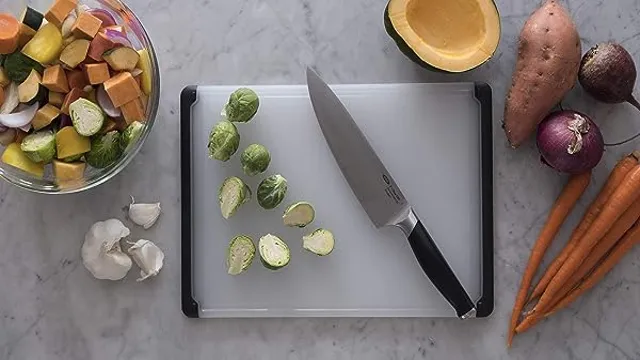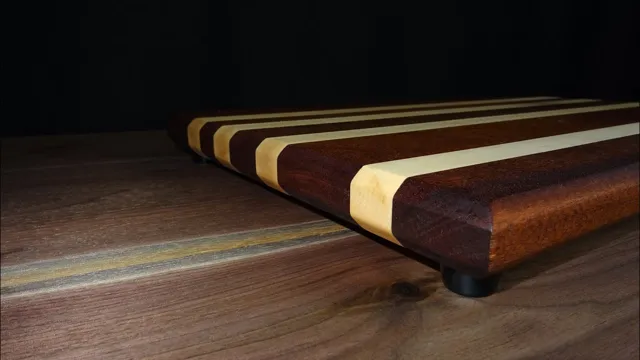How to Price Cutting Boards: A Comprehensive Guide for Woodworkers

Cutting boards are essential kitchen tools that are used daily to prepare meals. As such, they come in different shapes, sizes, and materials. With the variety of options available in the market, it can be challenging to determine the best board that suits your needs.
Moreover, pricing differences among boards can make it more confusing to choose the ideal cutting board. In this comprehensive guide, we shall delve into various factors to consider when pricing cutting boards. We shall explore the different types of cutting boards in the market, their advantages and disadvantages, and what affects their pricing.
Whether you are a professional chef or a home cook, this guide will provide you with crucial insights to help you make an informed decision when purchasing a cutting board.
Factors to Consider When Pricing Cutting Boards
When it comes to pricing cutting boards, there are a few factors that you should consider. First and foremost, you should factor in the cost of materials. The type of wood that you use for your cutting board will impact the price.
Hardwoods like maple or walnut are typically more expensive than softer woods like pine. You’ll also want to factor in the cost of tools and equipment, as well as your own time and labor. Another important consideration is the quality and craftsmanship of your cutting board.
If you’re making handmade cutting boards that are unique and well-designed, you may be able to charge a higher price. It’s also important to consider the market and your competition. Take a look at other cutting board sellers in your area and try to make your prices competitive.
With these factors in mind, you should be able to set prices for your cutting boards that are fair to both you and your customers.
Materials: Wood vs. Non-Wood Options
When it comes to pricing cutting boards, one of the factors to consider is the materials used. Wood and non-wood options are both available, and each has its pros and cons that can affect the final price. Wood cutting boards are popular due to their beauty and durability.
They are also easy on knives, making them a great option for those who want to preserve their knife blades. However, wood boards can be more expensive due to the cost of wood and the crafting process. Non-wood options such as plastic or bamboo are more affordable and lighter in weight, but they can also be less durable and prone to scratches.
Ultimately, the materials used and the craftsmanship will influence the price of a cutting board. As a buyer, it’s important to consider your needs and preferences to determine what type of cutting board fits your budget and lifestyle.

Size: Small vs. Large
When it comes to pricing cutting boards, one of the key factors to consider is the size of the board. Small and large cutting boards both have their advantages and disadvantages, and it’s important to take these into account when determining the right price point. For smaller cutting boards, the main advantage is their convenience.
They’re easy to store and transport, making them a great option for those with limited counter space or who need to take their cutting board on the go. Additionally, smaller cutting boards are often less expensive to produce, so they may be a more budget-friendly option for consumers. However, larger cutting boards offer more cutting surface area, which is a major plus for those who do a lot of meal prep.
They also look impressive in the kitchen and can serve as a serving tray for charcuterie or other appetizers. Of course, larger boards may also come with a higher price tag and can be more difficult to store. Ultimately, the best size for a cutting board will depend on the needs and preferences of the individual consumer.
Design: Standard vs. Custom
Cutting boards are an essential tool in every kitchen, and the pricing of a cutting board depends on several factors. One of the most significant considerations is design, which can be either standard or custom. Standard cutting boards are mass-produced and readily available at most retailers and online stores.
These boards are usually made from wood or plastic and come in standard sizes, shapes, and designs. On the other hand, custom cutting boards are made to order, according to the customer’s specific requirements. These boards are handcrafted and offer a unique, one-of-a-kind design that can add value to any kitchen.
However, custom cutting boards are more expensive than standard boards due to the time and effort required to create them. In addition, the type of wood or material used, the size of the board, and any additional features such as grooves or engravings can also affect the price. As a buyer, you need to consider your budget and the intended use of the cutting board before deciding between a standard or custom design.
Standard cutting boards are ideal for everyday use and are more affordable, while custom cutting boards are perfect for special occasions or as gifts for loved ones. Whichever option you choose, make sure the cutting board is made from high-quality materials, is durable, and easy to maintain. A well-crafted cutting board can last for years and provide an excellent cutting surface for all your culinary needs.
So, always make your choice wisely considering all these factors to get the most value out of your budget.
Researching Market Prices for Cutting Boards
When it comes to pricing cutting boards, researching the market is crucial. It’s important to not only consider the cost of materials and labor, but also the prices of similar boards being sold by competitors. Start by checking out online marketplaces such as Etsy, Amazon, and even Instagram.
Look for cutting boards made from similar materials and in similar styles to yours. Take note of the prices they are selling for, as well as any unique features or details that set them apart. This information can help guide your pricing strategy and ensure that you’re offering a fair price for your product.
Keep in mind that factors such as quality, design, and customer service can also influence a customer’s willingness to pay. By doing your research and finding the sweet spot between affordability and profitability, you can create a successful cutting board business.
Comparing Prices from Competitors
When it comes to purchasing a cutting board, the price can range significantly depending on the material and size. It’s important to research the market prices of cutting boards from various competitors to ensure that you’re getting the best deal possible. One effective way of doing this is by checking out different websites and stores that sell cutting boards.
Not only will this provide an idea of the different types of cutting boards available, but it also offers a comparison of the prices from different sellers. Additionally, it’s crucial to review the features of each cutting board to see how they might affect the price. For example, a bamboo cutting board may cost less than a wooden one, but it could also have a shorter lifespan.
By doing your due diligence in researching and comparing prices, you can make an informed decision and feel confident in your purchase. So, before you buy your next cutting board, take a little extra time to look around and compare prices – you never know what kind of deal you might find!
Determining a Profit Margin
When creating a cutting board business, one of the most important considerations is determining a profitable margin. To do this, researching market prices is essential. Start by looking up the prices of similar products in online marketplaces like Etsy or Amazon.
This will give you an idea of what people are willing to pay for handmade cutting boards. Additionally, you can visit local farmers’ markets, craft shows, and other similar events to see what prices vendors are charging. Remember to consider the cost of materials, labor, and time when determining your own pricing.
Once you have a clear understanding of market prices, you can set your own prices that provide a reasonable profit margin while still being competitive in the market. By doing your research, you can ensure that your cutting board business is profitable while also providing customers with a high-quality, well-priced product.
Setting a Competitive and Profitable Price
If you’re looking to sell cutting boards, pricing them right is crucial. Start by considering your costs, including materials, labor, and any other expenses involved in creating your product. Once you have a good grasp of your costs, you can begin determining your profit margin and setting a competitive price.
It’s also important to research your competition and see what similar cutting boards are selling for in your market. You don’t want to price too high and drive away potential customers, but you also don’t want to sell yourself short by setting your price too low. Remember that customers are often willing to pay a premium for high-quality, unique products.
Don’t be afraid to charge what your cutting boards are worth, especially if they’re made with high-quality materials and crafted with care. By pricing your cutting boards competitively and strategically, you can take your business to the next level and stand out in a crowded market.
Using a Pricing Formula
To set a competitive and profitable price for your product, using a pricing formula can be incredibly helpful. By taking into account the cost of production, desired profit margin, and the price competitors are charging for a similar product, you can come up with a price that is fair to both you and your customers. However, keep in mind that pricing is also a subjective matter.
While you want to make a profit, you also don’t want to price yourself out of the market. It’s important to strike a balance between making a profit and offering a price that is attractive to customers. You may need to adjust your pricing strategy over time as market conditions change.
Remember, your goal is to provide value to your customers while still making a profit for yourself. By using a pricing formula and keeping a pulse on the market, you can achieve both.
Adjusting Prices Based on Market Demand
Setting a competitive and profitable price is essential for any business, but determining the right price can be challenging. One effective way to set prices is by adjusting them based on market demand. Understanding the supply and demand factors that influence your product or service can help you determine the optimal pricing strategy.
For instance, if the demand for your product is high, you can set a higher price, and if the demand is low, you can lower your price to attract more customers. However, setting prices too high can risk turning off potential customers, while setting them too low can lead to decreased profits and undervaluing your product. Therefore, it’s crucial to find the right balance and do market research to know your competition’s pricing and consumer preferences to set a competitive and profitable price for your business.
Overall, adjusting your prices based on market demand can help you stay ahead of your competition and maximize profits.
Conclusion: Keep Experimenting with Pricing Strategies
Pricing cutting boards can be a tricky task that requires a delicate balance between material cost, labor, and design. Like a well-seasoned piece of meat, the perfect price should leave a delicious taste in the customer’s mouth while also leaving a fair profit for the seller. So, choose your wood wisely, craft with care, and don’t be afraid to add a sprinkle of creativity in the mix.
And remember, just like a good chef, a good woodworker knows that the secret ingredient is always love.”
FAQs
What factors should be considered when pricing cutting boards?
Factors to consider when pricing cutting boards include the cost of materials, labor, and any additional expenses such as shipping or packaging.
How much should I charge for a handmade cutting board?
The price of a handmade cutting board depends on multiple factors such as the type of wood used, the size of the board, and the overall design. A good rule of thumb is to charge at least two to three times the cost of materials and labor.
Are cutting board prices negotiable?
As with any handmade item, there may be some room for negotiation, but it ultimately depends on the seller’s business model and profit margin. It may be helpful to offer discounts for bulk purchases or repeat customers.
Should I consider my competition’s pricing when deciding how to price my cutting boards?
It is important to be aware of the competition’s pricing, but ultimately you should base your pricing on your own unique costs and profit margin. Consider factors such as the quality of materials used, the level of craftsmanship, and any special features or bonuses you offer.
How can I justify a higher price for my cutting boards?
Justifying a higher price for cutting boards can be done by emphasizing the quality of materials used, the level of craftsmanship, and any special features or bonuses included such as custom engravings or unique designs. It may also help to provide detailed information about the manufacturing process and the care and maintenance required for the board.
What is the average price range for cutting boards?
The average price range for cutting boards varies depending on the size, materials, and design. However, most cutting boards range from $20 to $150, with higher-end boards made from exotic woods or featuring intricate designs fetching prices of $200 or more.
Can I offer discounts for imperfect or “second quality” cutting boards?
Offering discounts for imperfect cutting boards or those with minor flaws can be a good way to make use of materials that would otherwise go to waste. However, be sure to clearly label these items as “second quality” and offer them at a significant discount compared to your regular prices.




